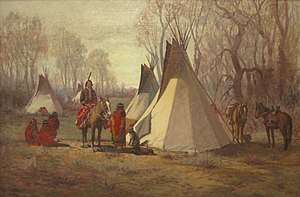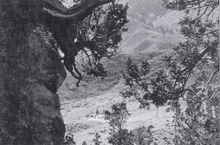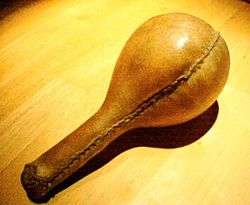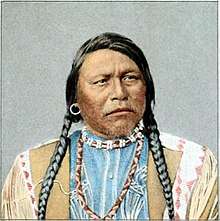Uncompahgre Ute
The Uncompahgre Ute is a band of the Ute, a Native American tribe located in the US states of Colorado and Utah. It was formerly called the Tabeguache.

Tabeguache
The Tabeguache (Taveewach,Taviwach, and Taviwac),[1] or “People of Sun Mountain,” was the largest of the ten nomadic bands of the Ute and part of the Northern Ute People.[2] They lived in river valleys of the Gunnison River and Uncompahgre River[3] between the Parianuche to the north and the Weeminuche to the south. They traveled seasonally.[4] Like other Ute, they were hunters who followed and hunted buffalo, deer, and elk. They moved their camp about every month, and created a link to Mother Earth at each camp by constructing a medicine wheel at the center of camp.[2]
The Tabeguache believed that the Pikes Peak region is their home. Their name for Pikes Peak is Tavakiev, meaning sun mountain. Living a nomadic hunter-gatherer lifestyle, summers were spent in the Pikes Peak area mountains, which was considered by other tribes to be the domain of the Utes.[5] Pikes Peak was a sacred ceremonial area for the Tabeguache Utes, or people of Sun Mountain, including their Sundance grounds and culturally scarred Ponderosa Pines that were used for different purposes, including prayer, burial, peeled-bark medicine, and arborglyphs or message trees. Some of the trees are 800 years old. An endowment was established by the Pikes Peak Historical Society in 2001 to help members of the Ute Nation to return to their homelands around Pikes Peak.[2]

In the fall they would travel Ute Pass and visit the springs where they "made offerings to the spirits of the springs for good health and good hunting".[5] There were about ten mineral springs, called manitou for the "breath of the Great Spirit Manitou" believed to have created the bubbles, or "effervescence", in the spring water. The springs were considered sacred grounds where Native Americans drank and soaked in the mineral water to replenish and heal themselves. Ute and other tribes came to the area, spent winters there, and "share[d] in the gifts of the waters without worry of conflict."[6][7][8][9] Artifacts found from the nearby Garden of the Gods, such as grinding stones, "suggest the groups would gather together after their hunt to complete the tanning of hides and processing of meat."[5][10]
The old Ute Pass Trail went westward from Monument Creek (near Roswell) to Garden of the Gods and Manitou Springs to the Rocky Mountains.[11] From Ute Pass, Utes journeyed eastward to hunt buffalo. They spent winters in mountain valleys where they were protected from the weather.[5][10] The North and Middle Parks of present-day Colorado were among favored hunting grounds, due to the abundance of game.[12]
John Wesley Powell lived with the Northern Ute People in 1868-69 and he observed:
- "[the Ute] will never ask to what nation or tribe or body of people another Indian belongs but to ‘what land do you belong and how are you land named?’ Thus the very name of the Indian is his title deed to his home and thus it is that these Indians have contended so fiercely for the possession of the soil…His national pride and patriotism, his peace with other tribes, his home and livelihood for his family, all his interests, everything that is dear to him is associated with his country."[2]
Mechanoluminescence

The Uncompahgre Ute Indians from Central Colorado are one of the first documented groups of people in the world credited with the application of mechanoluminescence involving the use of quartz crystals to generate light.[13][14] See also Triboluminescence.
Notable people
- Chipeta, Ouray's wife, Tabeguache
- Ouray (Ute leader), Tabeguache
References
- Clark, Patricia Roberts (June 23, 2009). Tribal Names of the Americas: Spelling Variants and Alternative Forms, Cross-Referenced. McFarland. p. 249. ISBN 978-0-7864-5169-2.
- "Ute Indians". Pikes Peak Historical Society. Retrieved June 14, 2018.
- "Frontier in Transition: A History of Southwestern Colorado (Chapter 5)". National Park Service. Retrieved June 18, 2018.
- Bakken, Gordon Morris; Kindell, Alexandra (February 24, 2006). "Utes". Encyclopedia of Immigration and Migration in the American West. SAGE. ISBN 978-1-4129-0550-3.
- "Ute Indians of Colorado". Colorado Springs Pioneers Museum. Retrieved May 24, 2013.
- Manitou Springs Historic District Nomination Form. History Colorado. Retrieved May 3, 2013.
- Historic Manitou Springs, Colorado - 2013 Visitors Guide. The Manitou Springs Chamber of Commerce, Visitors Bureau & Office of Economic Development. 2013. p. 6.
- Best of Colorado. Big Earth Publishing. 1 September 2002. p. 82. ISBN 978-1-56579-429-0. Retrieved May 4, 2013.
- About. Manitou Springs. Retrieved May 4, 2013.
- "The First People of the Cañon and the Pikes Peak Region". City of Colorado Springs. Archived from the original on July 3, 2014. Retrieved May 24, 2013.
- Howbert, Irving (1970) [1925/1914]. Memories of a Lifetime in the Pike's Peak Region (PDF). The Rio Grande Press. ISBN 0-87380-044-3. LCCN 73115107. Retrieved June 17, 2018 – via DaveHughesLegacy.net.
- William B. Butler (2012). The Fur Trade in Colorado. Western Reflections Publishing Company. p. 4. ISBN 978-1-937851-02-6.
- BBC Big Bang on triboluminescence
- Timothy Dawson Changing colors: now you see them, now you don't Coloration Technology 2010 doi:10.1111/j.1478-4408.2010.00247.x
